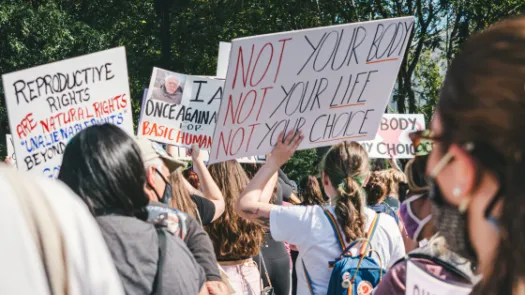
All about PI’s work on reproductive rights and privacy
Spotlight on PI's Reproductive Rights and Privacy Project!
- The right to privacy is one of the precedents used to establish reproductive rights.
- The Project is focused on researching and exposing organisations that collect and exploit the information of those seeking to exercise their reproductive rights.

We are excited to spotlight our Reproductive Rights and Privacy Project!
The Project is focused on researching and exposing organisations that collect and exploit the information of those seeking to exercise their reproductive rights. Working together with PI partners, other international grassroots organisations and NGOs, PI is researching and advocating against this data exploitation.
So, what are reproductive rights?
Sexual and reproductive rights, which are contained within Economic, Social, Cultural, and Environmental Rights, include the right to access to contraception, the right to safe and legal abortion, the right to sexual health information including about contraception and abortion, and other reproductive health services.
Also of relevance are issues including disinformation in sexual health information, burdensome processes or costs to accessing reproductive healthcare, non-medical and dangerous processes being introduced into reproductive healthcare legislation, aid money (for example US aid money) having strings attached that require international recipients to promulgate biased health information, and discrimination in providing reproductive healthcare, whether the discrimination is based on income, location, race or ethnicity, gender identity, sexuality, or otherwise.
How do reproductive rights connect to the right to privacy?
The right to privacy is one of the precedents used to establish reproductive rights, and it is established by several international and regional legal instruments. The primary link between the two stems from the fact that laws and policies which impede upon individuals’ rights to access sexual and reproductive health services may also interfere with individuals’ right to privacy and to make autonomous decisions as it pertains to their health and fertility. Such reproductive rights are necessary for the bodily autonomy.
Tell me about how reproductive rights are established…
- The Right to Health is in part established by Articles 10 and 12 of the International Covenant on Economic, Social and Cultural Rights. This refers to all persons’ right to the highest attainable standard of health and includes the right to sexual and reproductive health. With respect to sexual and reproductive health, states have an obligation to eliminate discrimination accessing these services, ensure free and informed consent, reduce infant and maternal morbidity and mortality, ensure that dangerous practices do not impede pre-and post-natal care and access to contraception, and protect vulnerable or marginalized groups of society.
- The Right to Non-Discrimination and Equal Treatment in Law is in part established by Article 2 of the International Covenant on Economic, Social and Cultural Rights, Article 1 of the American Convention on Human Rights, and Articles 1 and 2 of the Convention on the Elimination of All Forms of Discrimination against Women. This right refers to every person’s right to enjoy human rights without discrimination. With respect to reproductive rights, the Convention on the Elimination of All Forms of Discrimination Against Women prohibits all expressions of discrimination against women. Laws or policies that inhibit women’s right to control their fertility, by restricting access to Sexual and Reproductive Health services or by requiring women to have their husband’s consent to access sexual and reproductive health services violate this right.
- The Right to Life is in part established by Article 3 of the Universal Declaration of Human Rights, Article 6 of the International Covenant on Civil and Political Rights, and Article 4 of the American Convention on Human Rights. This right pertains to signatory states’ obligations to implement positive actions to protect life. According to the World Health Organization(WHO), in 2017 approximately 810 individuals died every due to avoidable causes during pregnancy and childbirth. Preventing individuals from accessing the vital sexual and reproductive health services that will allow them to prevent or delay pregnancy or ensure a healthy pregnancy increases their risk of mortality, and represents a violation of this right.
- The Right to Physical Integrity is in part established by Article 7 of the International Covenant on Civil and Political Rights and Article 5 of the American Convention on Human Rights. This right refers to individuals’ right to freedom from torture and other cruel, inhumane, or degrading treatment and to be free from medical or scientific intervention, except with their full consent. This right necessitates every persons’ right to exercise control over their own bodies, including with regard to their sexual and reproductive life. Rape, forced abortion, forced sterilization, female genital mutilation, and domestic abuse may all constitute violations of this right.
- The Right to Marry and Establish a Family is in part established by Article 23 of the International Covenant on Civil and Political Rights, Article 19 of the International Covenant on Economic, Social and Cultural Rights, and Article 16 of the Convention on the Elimination of All Forms of Discrimination. This right refers to couples’ right to choose if they would like to have children, become pregnant and have a child, as well as their right to choose the number, timing, and spacing of their children. In 1990, the Human Rights Committee which monitors the International Covenant on Civil and Political Rights published a General Comment specifying that any signatory state sponsored family planning policies should not be discriminatory or compulsory, in line with Article 23.
- The Right to Privacy is established by Article 17 of the International Covenant on Civil and Political Rights, Article 16 of the Children’s Rights Convention, Article 22 of the Disability Rights Convention, Article 8 of the European Convention on Human Rights, Article 10 of the Convention on Human Rights and Biomedicine, and Article 11 of the American Convention on Human Rights. This right includes the right to confidentiality in the provision of sexual and reproductive health services, especially as it pertains to potentially sensitive issues like HIV/AIDS status, pregnancy, and visits to sexual and reproductive health service providers. This is particularly important for vulnerable groups like adolescents, people living with HIV, and people living with disabilities. This right may be violated by policies which require women to have their husband’s consent for sterilization or those which require health personnel to disclose individuals who have undergone abortion.
This work is part of a broader programme of work aimed at safeguarding the dignity of people by challenging current power dynamics, and redefining our relationship with governments, companies, and within our own communities. As an enabling right, privacy plays an important role in supporting the exercise of reproductive rights as recognised in international human rights law.
So, what’s next?
With others, we are continuing to document instances where those seeking to exercise their reproductive rights or access reproductive healthcare have had their data exploited. We are collecting evidence with international partners to show the variance in how reproductive rights are being curtailed and to highlight the experiences of different people in different places.
Some of the Projects recent work:
- We filed a submission to the UK Government’s consultation on a new legal framework for abortion services in Northern Ireland.
- We showed how Heartbeat International is developing and promoting data exploitative technologies to its international network of affiliate anti-abortion crisis pregnancy centres.
If you are an organisation that works on this or a similar issue, please reach out to us and tell us about your organisation’s work.



